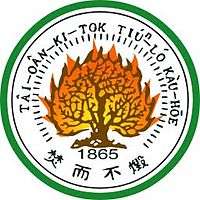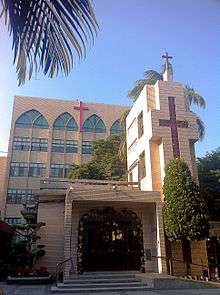Presbyterian Church in Taiwan
| Presbyterian Church in Taiwan Tâi-oân Ki-tok Tiúⁿ-ló Kàu-hoē 台灣基督長老教會 | |
|---|---|
 | |
| Classification | Protestant |
| Orientation | Mainline |
| Polity | Presbyterian |
| Moderator | Rev. Tin Bun-jin |
| Associations | World Council of Churches, Christian Conference of Asia, National Council of Churches of Taiwan, World Communion of Reformed Churches, Council for World Mission |
| Region | Taiwan |
| Founder | James Laidlaw Maxwell and George Leslie Mackay |
| Origin |
1865 Taiwan |
| Congregations | 1,219[1] |
| Members | 238,372[2] |
| Ministers | 1,205[1] |
| Hospitals | Mackay Memorial Hospital |
| Secondary schools | 3 |
| Tertiary institutions | 6 (incl. 3 seminaries and 1 bible college) |
| Official website | www.pct.org.tw |
The Presbyterian Church in Taiwan (PCT; Pe̍h-ōe-jī: Tâi-oân Ki-tok Tiúⁿ-ló Kàu-hoē; Chinese: 台灣基督長老教會) is the largest Protestant Christian denomination based in Taiwan.[3]
History
It was started there in the 19th century by Dr. James Laidlaw Maxwell Sr. of the Presbyterian Church of England and Dr. George Leslie Mackay of the Presbyterian Church in Canada.
In Taiwan, Presbyterians have historically been active in promoting the use of the local vernacular Taiwanese, both during the Japanese colonial period, as well as after the transfer of rulership to the Republic of China, during which the exclusive use of Mandarin was legally mandated. Also, the church has historically been an active proponent of human rights and democracy in Taiwan, a tradition which began during the Japanese colonial period and extended into the martial law period of the ROC. The Presbyterian Church is heavily involved in the evangelisation among the aborigines since the 1930s. Today about 30 percent of the native Taiwanese belong to the Taiwanese Presbyterian denomination. The most rapid church growth was experienced from 1955 to 1965 during the Double Church Movement. From 1978 the denomination was engaged in an extensive evangelisation effort known as the Ten One Movement aimed at 10% increase of the communicant membership each year.[4]
As such, the church has been somewhat associated with the Taiwan independence movement. The PCT has also been a consistent and conspicuous proponent of Aboriginal Rights:
| “ | … over 64 percent [of Taiwanese aborigines] identify as Christian… [For decades, the PCT] has used its organizational strengths to mobilize its people for repeated campaigns, and has provided a continuing solid institutional base for most Aboriginal political initiatives …organizations like the Alliance of Taiwanese Aborigines – and even the DPP itself – have often fallen back on the Church as a ready-made resource. (Stainton 2002)[5] | ” |
Governance
In terms of polity, the PCT has a general assembly, and only one synod (the Northern Synod); the presbyteries in the south of the island connect directly to the general assembly.[6] It has approximately 20 presbyteries, four districts and a General Assembly.[4]
Interchurch relations
The PCT is a member church of the World Council of Churches and the World Communion of Reformed Churches. It is also a member of the Council for World Mission through which it is linked in mission with 30 other churches around the world.
Immigrants from Taiwan to the United States and Canada have also started Taiwanese-language churches which are closely related to the Presbyterian Church in Taiwan. While most of these churches are affiliated with the Presbyterian Church (USA), or the Presbyterian Church in Canada, the United Church of Canada, the liturgy and church practices are rooted in the Taiwanese Presbyterian tradition, and the pulpits are usually filled by ministers trained in the PCT.[7]
The Mackay Memorial Hospital is affiliated with the Presbyterian Church in Taiwan.
Doctrine

The church subscribes to:[4]

See also
- Mackay Memorial Hospital
- Presbyterianism
- Reformed churches
- History of Taiwan
- Chun-Ming Kao
- Christianity in Taiwan
References
- 1 2 "Presbyterian Church in Taiwan". World Council of Churches. Retrieved 2010-11-06.
- ↑ "The Presbyterian Church in Taiwan (PCT)".
- ↑ "BBK.GKV » Taiwan".
- 1 2 3 "Address data base of Reformed churches and institutions".
- ↑ Stainton, Michael (2002). "Presbyterians and the Aboriginal Revitalization Movement in Taiwan". Cultural Survival Quarterly. 26 (2). Retrieved 2007-03-21.
- ↑ "Taiwan Church News".
- ↑ "關於我們 - 台灣基督長老教會".
External links
- Presbyterian Church in Taiwan (General Assembly)
- Hsin-Yi Presbyterian Church in Taiwan (English Section)